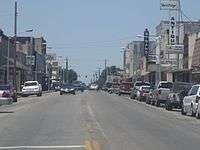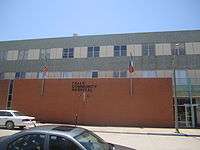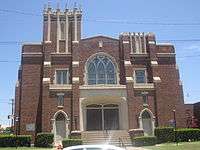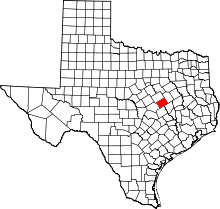Marlin, Texas
| Marlin, Texas | |
|---|---|
| City | |
|
Marlin Mineral Water Pavilion, 2011 | |
| Nickname(s): The Mineral Water City of Texas | |
 Location of Marlin, Texas | |
| Coordinates: 31°18′29″N 96°53′35″W / 31.30806°N 96.89306°WCoordinates: 31°18′29″N 96°53′35″W / 31.30806°N 96.89306°W | |
| Country |
|
| State |
|
| County |
|
| Settled | 1834 |
| Incorporated | 1867 |
| Government | |
| • Type | Council-Manager |
| • Mayor | Betty Nelson |
| Area | |
| • Total | 4.6 sq mi (11.8 km2) |
| • Land | 4.5 sq mi (11.7 km2) |
| • Water | 0.04 sq mi (0.1 km2) |
| Elevation | 390 ft (119 m) |
| Population (2010) | |
| • Total | 5,967 |
| • Density | 1,321/sq mi (510.1/km2) |
| Demonym(s) | Marlinite |
| Time zone | Central (CST) (UTC−6) |
| • Summer (DST) | CDT (UTC−5) |
| ZIP code | 76661 |
| Area code | 254 |
| FIPS code | 48-46740[1] |
| GNIS feature ID | 1362189[2] |
| Website |
www |





Marlin is a city in Falls County, Texas, United States. The population was 6,628 at the 2000 census but decreased by 10 percent to 5,967 in 2010.[3] Since 1851, it has been the third county seat of Falls County. Marlin has been given the nickname "the Hot Mineral Water City of Texas". Mineral waters were found there in 1892.
History
Establishment
The city of Marlin is located 4 miles (6 km) east of the Brazos River, which runs through the center of the county. The low falls on the river southwest of present-day Marlin was the site of Sarahville de Viesca, established in 1834 by Sterling C. Robertson. Marlin was incorporated in 1867. It is named after a pioneer patriot, John Marlin. His son-in-law, Samuel A. Blain, laid out streets and lots and drafted a map around a square. Three churches – Presbyterian, Methodist, and Baptist — were given lots first and relocated to the east side of the square. Zenas Bartlett's General Store was the first business to be established in Marlin. When Bartlett's wife died, the store was deeded to the city and used as a town hall. A simple brick building temporarily stood as a school. The first of four county courthouses was a log cabin. It was used for county business and court, a school, a church, a meeting place for political and community events, and as a dance hall. The fourth and present courthouse was constructed in 1938 and 1939, after the third courthouse, which was built in 1887, was declared unsafe.
Before Falls County was organized, the settlement of Marlin already had established private schools. A tuition school, Marlin Male and Female Academy, was located on Ward Street in 1871, north of the public square. The school was renamed and relocated before finally being sold in 1886, only to be destroyed by fire in 1900. A new public brick school was constructed in 1903. The Marlin Independent School District was established in 1923. Nearly half a century before in 1875, two other schools for African Americans were organized. The two black schools were dependent on state funds, and met in the African and Baptist churches. In 1916, the city council voted to build a school for blacks, which after it was first built, it was moved to Commerce Street, and named "Booker T. Washington". The two school districts merged in 1968 into the Marlin Independent School District. In 1900, the town's Jewish residents organized a Sunday school.[4]
The 1890s and early 20 century; Falls and Arlington hotels
Despite not officially going over 8,000 (the largest population was recorded by the official US Census at about 7,900 in both 1950 and 1980) Marlin did get many tourists from around the country for its famous mineral water, which was believed to heal any sickness or pain, by bathing in it. Even though the waters had a smell to them, they still seemed to be "magic" when people bathed in the stuff, and actually felt better. Bath houses were opened around the town of Marlin so people could come and takes bathes in the mineral water, after it was discovered in 1892 during the search for an artesian well. The mineral water had put the town on the map as hundreds of thousands of tourists flocked to the area. With the end of World War II and the advent of penicillin there began a national and local decline in the hot mineral bath industry.
The Bank of Marlin was opened in 1892 and operated until the early 1960s.
The Cincinnati Reds baseball team held spring training in Marlin in 1907.[5] The New York Giants baseball team (now the San Francisco Giants) held spring training in Marlin from 1908 to 1918.[6][7]
In 1929, Conrad Hilton built his eighth Hilton Hotel in his chain in Marlin, the nine-floor, 110-room Falls Hotel, which could be seen for miles from the city limits of Marlin. Across the street was the Marlin Sanitarium Bathhouse. An underground tunnel connected the two buildings.
A fire destroyed the underground tunnel, the Sanitarium Bath House and Buie Clinic. Except for three businesses located on the ground floor, the Falls Hotel was subsequently closed. The hotel building remains the tallest building in Falls County. The location of the bath house is adjacent to the city post office, and a gazebo and park occupy the site of the bathhouse and clinic buildings. The Arlington Hotel was first built as a three-floor hotel in 1895, and burned in 1899. An even more grand structure made of brick and stone followed, and was the headquarters of the New York Giants baseball team from about 1900–1920. When in about 1930 the Moody family of Galveston bought the Marlin Hilton Hotel from Conrad Hilton's first venture into his failed hotel business, the Moody's bought and tore down the Arlington Hotel to eliminate any competition.
The first floor of the Falls Hotel is the only part of the hotel that the public may visit. Original rooms of the hotel are now a Mexican restaurant, a beauty salon, and an eye doctor. City events are also held in the ballroom of the Falls Hotel.
Along with the decline of the hot mineral industry, almost all other "bathhouse related" business were, over the years, closed and their structure demolished. Mineral water now can only be obtained from a fountain outside the Marlin Chamber of Commerce.
Modern utilities in Marlin
Phones began appearing in households in Marlin in the year 1900. Automobiles, electricity, and Lone Star Gas followed shortly. By the mid-1900s, Marlin had a bottling company, stock pens, a brickyard, a turkey-processing plant (building can still be seen on Williams Street/South Business Highway 6), a saddlery, a water crystallization plant, and a pottery plant.
The 2000s
At the census in 2000, Marlin had a population of 6,628, an increase of 242 people from 1990, when Marlin had a population of 6,386. The population of Marlin had declined to 5967 residents as of 2010.
Wallace, a business-form printing company which was the employer of hundreds in Marlin, closed in the mid-2000s. Marlin Mills, a carpet manufacturing company, closed with the 1980s economic decline. A styrofoam company that had been open in another building in Marlin's declining industrial park caught fire and the remains were demolished. The Thomas T. Connally Veteran's Affair Hospital, a five-floor building in the residential area of Marlin, located at the corner of Ward and Virginia streets, closed in 2005, losing more than a hundred jobs as the economy in Marlin continued to struggle.
By 2009, different census estimates had said that Marlin's population had decreased by 400 to 800 people. An article in the Waco Tribune-Herald reported that Marlin could grow, having noted the establishment of a $10-million water plant. The article mentions a three-floor, sixty-room Best Western Hotel under construction on Highway 6 at Farm-to-Market Road 147. The Texas Department of Criminal Justice was establishing a hospital for prisoners at the former Veterans' Affairs Hospital which was expected to employ 100 to 150 persons. However, funds for the proposed Texas Department of Criminal Justice hospital were reallocated to renovate the TDJC hospital in Galveston which was badly damaged by Hurricane Rita.
2011
The Heart of Texas Council of Governments granted the city of Marlin $35,000 to remove fifteen dilapidated buildings and structures in the town, which included 300 tons of debris.[8] Over 6 miles (10 km) of water lines were constructed on 20 streets in 2011.[9] The city also started and completed a 500,000-gallon water tower project.
In 2011, the city brought back its Annual Music and Blues Festival, and raised money to revamp the city baseball fields and revive the City Little League, which attracted 160 children that year.[10][11]
The city's crime rate decreased by 45 percent in 2011.[12]
2015
On November 10, 2015, Marlin Chief of Police Darrell Allen died while in office. Chief Allen had suffered a gunshot while at an off-duty security job in Temple on November 1. The suspect was placed into custody at the scene by other officers working security.[13]
In December 2015 a protest occurred after the city water had been turned off for almost a week. The event was originally a rally supporting jobs in Marlin and a pro-Marlin ISD rally.[14]
Geography
Marlin is located in east-central Falls County at 31°18′29″N 96°53′35″W / 31.30806°N 96.89306°W (31.307975, -96.892975).[15] Texas State Highway 6 runs along the eastern edge of the city, leading northwest 30 miles (48 km) to Waco and southeast 56 miles (90 km) to Bryan. Texas State Highway 7 runs through the center of town as Bridge Street and Live Oak Street, leading east 16 miles (26 km) to Kosse and west 10 miles (16 km) to Chilton.
According to the United States Census Bureau, the city has a total area of 4.6 square miles (11.8 km2), of which 4.5 square miles (11.7 km2) is land and 0.04 square miles (0.1 km2), or 1.09%, is water.[16]
Transportation
Highways and other major roads
- Texas State Highway 6, also known as Williams, Craik Streets in city limits.
- Texas State Highway 7, also known as Bridge, Live Oak Streets in city limits.
- Farm-to-market road 147, starts at Highway 7 and ends at Highway 14 less than four miles southwest of Groesbeck.
Airport
Marlin and Falls County are served by the Marlin Municipal Airport, located 4 miles (6 km) northeast of the center of Marlin.
Demographics
| Historical population | |||
|---|---|---|---|
| Census | Pop. | %± | |
| 1870 | 500 | — | |
| 1880 | 1,500 | 200.0% | |
| 1890 | 2,058 | 37.2% | |
| 1900 | 3,092 | 50.2% | |
| 1910 | 3,878 | 25.4% | |
| 1920 | 4,310 | 11.1% | |
| 1930 | 5,338 | 23.9% | |
| 1940 | 6,542 | 22.6% | |
| 1950 | 7,099 | 8.5% | |
| 1960 | 6,918 | −2.5% | |
| 1970 | 6,351 | −8.2% | |
| 1980 | 7,099 | 11.8% | |
| 1990 | 6,386 | −10.0% | |
| 2000 | 6,628 | 3.8% | |
| 2010 | 5,967 | −10.0% | |
| Est. 2015 | 5,682 | [17] | −4.8% |
As of the census[1] of 2000, there were 6,628 people, 2,415 households, and 1,509 families residing in the city. The population density was 1,465.4 people per square mile (566.2/km²). There were 2,826 housing units at an average density of 624.8 per square mile (241.4/km²). The racial makeup of the city was 41.84% White, 44.48% African American, 0.27% Native American, 0.20% Asian, 0.02% Pacific Islander, 11.62% from other races, and 1.58% from two or more races. Hispanic or Latino of any race were 18.30% of the population.
There were 2,415 households out of which 30.2% had children under the age of 18 living with them, 35.7% were married couples living together, 22.5% had a female householder with no husband present, and 37.5% were non-families. 34.8% of all households were made up of individuals and 18.9% had someone living alone who was 65 years of age or older. The average household size was 2.47 and the average family size was 3.21.
In the city the age distribution of the population shows 33.2% under the age of 18, 7.4% from 18 to 24, 21.3% from 25 to 44, 18.9% from 45 to 64, and 19.3% who were 65 years of age or older. The median age was 35 years. For every 100 females there were 96.6 males. For every 100 females age 18 and over, there were 80.4 males.
The median income for a household in the city was $21,443, and the median income for a family was $26,861. Males had a median income of $25,220 versus $18,111 for females. The per capita income for the city was $13,555. About 27.9% of families and 31.3% of the population were below the poverty line, including 40.8% of those under age 18 and 16.8% of those age 65 or over.
Government and infrastructure
Municipal government
In December 2015 Damien Eaglin, then the acting police chief, was designated Marlin chief of police.[19] He replaced Darrell Allen, who was shot and killed in November of that year.[20]
State government
The Texas Department of Criminal Justice (TDCJ) operates the Marlin Unit, a transfer facility for men, in the City of Marlin. The unit opened in June 1992 and was transferred to the Texas Youth Commission (TYC) in May 1995.[21] When it was a part of TYC, the facility, named the Marlin Orientation and Assessment Unit,[22] served as the place of orientation for children of both sexes being committed into TYC from the facility's opening in 1995 to its transfer out of TYC in 2007.[23] In September 2007 the facility was transferred back to the TDCJ.[21] The 2007 conversions of the Marlin unit, to house 600 adult prisoners, had the possibility of improving the economy of Marlin. Around that time Texas officials were examining the possibility of converting a former Veterans Administration medical center in Marlin into a prison unit for psychiatric patients.[24]
The TDCJ also operates the William P. Hobby Unit, a prison for women located southwest of Marlin in unincorporated Falls County and named for former Lieutenant Governor Bill Hobby.[25]
Federal government
The United States Postal Service operates the Marlin Post Office.[26]
Education
The City of Marlin is served by the Marlin Independent School District.
Newspapers
The city of Marlin has had several newspapers. The current one that has been serving Marlin since 1890 is the Marlin Democrat, http://www.marlindemocrat.com issued every Wednesday. Other newspapers that were being published in the 19th and 20th centuries were The Falls County Freeman, ran by the black community. The Marlin Ball was first established in 1874 by T.C. Oltorf and continued until about the year of 1901. The Falls County Record was popular during the 1940s and 1950s. To this day, The Marlin Democrat and The Rosebud News remain the only active newspapers in Falls County.
Culture
Events
Marlinites have enjoyed the revival of the Marlin Music and Blues Festival since 2011.[27] Originally the Wood Street Blues Festival from 2003 to 2005, the event was held in late May on consecutive days in honor of musician Blind Willie Johnson, a former resident of Marlin.[28]
In May 2013, after a hiatus, the famous Marlin Festival Days returned to the city park.[29]
Filmed in Marlin
- Leadbelly (1976)[30] starring Roger E. Mosley; took place on and around Wood Street.
- Infamous (2006)[31] starring Sandra Bullock; took place around Falls County Courthouse and run-down homes of Marlin.
Notable people
- Danario Alexander, wide receiver who currently plays for the San Diego Chargers; born in Marlin and graduated from Marlin High School in 2006
- Ken "Coach" Carter (second home), who in the fall of 2009 opened up an unconventional boarding school in the town[32]
- Ben Clarkson Connally, federal district judge appointed by President Harry Truman
- Tom Connally, U.S. senator from 1928 to 1952; chairman of the Senate Foreign Relations Committee during World War II; member of the United States House of Representatives from 1918 to 1928
- Bruce Curry, world champion boxer, born in Marlin in 1956
- Bobbi Humphrey, jazz flautist and singer born in Marlin in 1950
- Blind Willie Johnson, blues/gospel street musician. Marlin is his attributed birthplace, although his birth records, if they exist, are lost. His birthplace has also been traced to Beaumont, Texas.
- Dan Kubiak state representative, graduated from Marlin High School in 1957[33]
- Curtis Modkins, offensive coordinator for the San Francisco 49ers
- O.L. Rapson, first manager of the Grand Rapids Hotel and manager of a small store outside of Marlin
- Ben Herbert Rice, Jr., federal district judge appointed by President Harry Truman
- LaDainian Tomlinson, New York Jets running back born in Marlin. Tomlinson Hill, an unincorporated community just 5 miles (8 km) west of Marlin, is named for his family.
- Phil Wellman, minor league baseball player and manager infamous for his tirade against umpires after ejection
Photo gallery
 Cotton compress, about 1905
Cotton compress, about 1905 Courthouse, about 1905
Courthouse, about 1905 Main Street, about 1905
Main Street, about 1905 "New High School", about 1905
"New High School", about 1905 Sanitorium, about 1905
Sanitorium, about 1905 Bath houses and Sanitorium, about 1905
Bath houses and Sanitorium, about 1905 Falls County Courthouse, March, 2009
Falls County Courthouse, March, 2009- Fountain running Marlin's hot mineral water
- Falls Hotel on Coleman St. in 2010
- Palace Theatre on Heritage Row in 2010
Climate
The climate in the area is characterized by hot, humid summers and generally mild to cool winters. According to the Köppen climate classification system, Marlin has a humid subtropical climate, abbreviated "Cfa" on climate maps.[34]
References
- 1 2 "American FactFinder". United States Census Bureau. Retrieved 2008-01-31.
- ↑ "US Board on Geographic Names". United States Geological Survey. 2007-10-25. Retrieved 2008-01-31.
- ↑ Marlin at the TexasAlmanac.com
- ↑ "Marlin, Texas", found in the Encyclopedia of Southern Jewish Communities,
- ↑ http://springtrainingonline.com/teams/cincinnati-reds.htm
- ↑ http://springtrainingonline.com/teams/san-francisco-giants.htm
- ↑ Alexander, Charles C. (1995). John McGraw. Bison Books, reprint from Viking. p. 48. ISBN 0-8032-5925-5.
- ↑ City Demolishes 15 Rundown structures
- ↑ City adds over six miles of water lines and 500,000 gallon water tower
- ↑ Marlin Blues Festival Returns After Five-Year Hiatus
- ↑ Season opens for Marlin Little League
- ↑ City's Crime Rate Significant Drop in 2011
- ↑ "Slain Police Chief’s Body Returned To Central Texas" (Archive). KWTX-TV. November 11, 2015. Retrieved on January 19, 2016.
- ↑ "March protests city leadership." The Marlin Democrat. Thursday December 10, 2015. Retrieved on January 19, 2016.
- ↑ "US Gazetteer files: 2010, 2000, and 1990". United States Census Bureau. 2011-02-12. Retrieved 2011-04-23.
- ↑ "Geographic Identifiers: 2010 Demographic Profile Data (G001): Marlin city, Texas". U.S. Census Bureau, American Factfinder. Retrieved August 22, 2016.
- ↑ "Annual Estimates of the Resident Population for Incorporated Places: April 1, 2010 to July 1, 2015". Retrieved July 2, 2016.
- ↑ "Census of Population and Housing". Census.gov. Retrieved June 4, 2015.
- ↑ "BREAKING NEWS - Eaglin named MPD chief." The Marlin Democrat. Thursday December 10, 2015. Retrieved on January 19, 2016.
- ↑ "BREAKING NEWS - MPD Chief Allen dies at hospital." Marlin Democrat. Thursday November 12, 2015. Retrieved on November 19, 2016.
- 1 2 "Marlin Unit." Texas Department of Criminal Justice. Retrieved on September 22, 2010.
- ↑ "Facility Address List." Texas Youth Commission. November 10, 2001. Retrieved on June 24, 2010.
- ↑ "How Offenders Move Through TYC." Texas Youth Commission. November 10, 2001. Retrieved on June 24, 2010.
- ↑ Ward, Mike. "Texas could get new adult prisons without building them" (Archive). Austin American-Statesman. Tuesday June 5, 2007. Retrieved on January 19, 2016.
- ↑ "Hobby Unit." Texas Department of Criminal Justice. Retrieved on September 22, 2010.
- ↑ "Post Office Location - MARLIN." United States Postal Service. Retrieved on September 22, 2010.
- ↑ Blues Festival is a great success
- ↑ The 'Blues' are back Festival
- ↑ Marlin gears up for the return of Festival Days
- ↑ Films Shot in Marlin
- ↑ Marlin, Texas film locations
- ↑ Coach Carter opens up boys academy
- ↑ "Daniel Kubiak". cemetery.state.tx.us. Retrieved June 7, 2011.
- ↑ Climate Summary for Marlin, Texas
External links
| Wikimedia Commons has media related to Marlin, Texas. |

